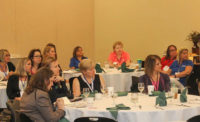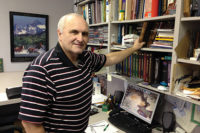
More than 30 representatives from the federal government,
energy utilities, foreign embassies, and the HVACR industry attended the 7th
Danfoss EnVisioneering Symposium.
More than 30 representatives from the federal government, energy utilities, foreign embassies, and the HVACR industry gathered in Washington, D.C. to answer a recurring question, “Is the tide turning with regard to the future of energy and energy-efficiency strategy?” And the answer was an emphatic yes from that group assembled for the 7th Danfoss EnVisioneering Symposium.
The daylong event featured presentations from five energy experts, followed by an interactive discussion of specific ways to address the global energy challenge, and some specific recommendations for public policy.
“The tide is turning, but we need to change our respective approaches,” said Robert Thompson, project manager of commercial energy efficiency programs for Pasadena (Calif.) Power and Water. “For example, utilities need to go outside the box and incorporate new energy-efficient technologies.”
For example, it was noted that Pasadena Power and Water created and now organizes an annual energy fair, where industry presents its best energy-efficient technologies for government, engineering firms, end users, and others. “The goal is to put energy savings first … and first costs second,” Thompson noted.
Jean Lupinacci, director of the EnergyStar Commercial and Industrial Branch, U.S. Environmental Protection Agency, agreed that the energy-efficiency tide is turning. The Energy Star program, which has 70 percent awareness among homeowners, is making inroads in the commercial building sector, she said.
Lupinacci noted that more than 4,000 buildings have earned the Energy Star label; these buildings use 40 percent less energy than average buildings. She added that trade associations, such as the Building Owners and Managers Association (BOMA), are offering Energy Star programs to their members, while several states and cities (she cited California, Washington, D.C., and Louisville) are embracing the model.
Other symposium speakers, and the key points they made, included:
• Darrell Beschen, chief economist for Energy Efficiency and Renewable Energy, U.S. Department of Energy (DOE), said the DOE will continue to research and develop renewable energy technologies in order to “create a balanced and diverse portfolio of solutions to address energy and environmental challenges.”
He noted that renewable energy, as a percentage of annual new energy capacity additions, increased from 2 percent in 2004 to 22 percent in 2006. “We’re trying to bring critical resources to critical technologies to (capitalize on) critical opportunities,” Beschen said.
• Thomas Hartman, president of The Hartman Co., building technologies consulting firm based in Georgetown, Texas, introduced a new white paper, “A Vision for Energy Performance-Based Building Design and Operations.” Its purpose is to merge public policy with a new focus on building energy performance. “The power of utilities needs to be redirected,” Hartman offered as one possible solution to the energy challenge. “For utilities, it’s a change from selling energy to managing energy.”
In keeping with the utilities theme, Drake Erbe, vice president of business development, Airxchange Inc., added: “Utilities can be part of the solution, not the problem. Until we give the right incentives to the right people, change [in energy-efficiency strategy] won’t happen.” Erbe is chairman of the Mechanical Subcommittee for ASHRAE Standard 90.1.
The symposium identified two recommendations:
• Decoupling electric utility revenue from kWh sales could motivate that industry to become a vehicle for accelerating conservation.
• Incentives and building code changes are needed to upgrade the installed base of old, inefficient equipment.
Robert Wilkins, president of Danfoss Inc. (U.S. and Canada), summed up the symposium, noting that all stakeholders can and should make valuable contributions to the global energy challenge.
“Energy-efficient technologies are available right now, and they’re making an impact in the U.S. and abroad,” Wilkins said.
“But we still have a long way to go to make those technologies universal. That’s why these symposia events are so valuable. New ideas and solutions - and new ways to apply them - come to the forefront at every event.”
The next Danfoss EnVisioneering Symposium will be held Nov. 14 in Carlsbad, Calif., just prior to the annual meeting of the Air-Conditioning, Heating and Refrigeration Institute, set for Nov. 16-18. The symposium, “The Challenge of Innovation: What the Private Sector Needs to Create a 21st Century, Energy-Efficient Environment,” will address how energy-efficiency technology is creating novel opportunities - and positive returns on investment - in the business environment.
For more information, visit www.envisioneering.danfoss.com/symposium.
Publication date:05/05/2008





